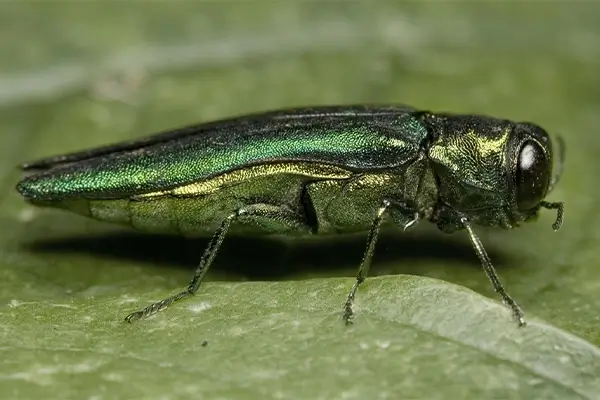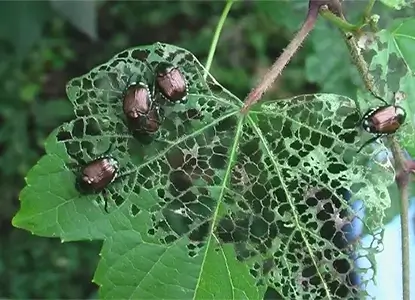Tree, Lawn & Landscape Insect Control
We provide insect control services throughout the Mequon, Milwaukee, Stevens Point, Wausau, and surrounding areas.
Does your tree or shrub look sick?
Tree & Shrub Insect Control
We offer a wide variety of treatments and services to correct insect problems.
Insects and even animals can cause a wide variety of damage to trees and shrubs. The good news is that many tree and shrub problems can be corrected, and plants can be returned to good health. Like with your own health, the key to solving problems is proper diagnosis. Using a wide variety of treatment methods, First Choice Tree Care will inspect and diagnose tree and shrub health issues and provide proactive treatment options for your sick trees.
Don't wait; call us today for a tree care evaluation or consultation to keep your trees alive and feeling great!

Treatments Options Include:
- Soil-applied systemic insecticides: Various products, specifically engineered to be absorbed by root systems, are injected into the soil near the base of the tree to control a wide variety of insect pests.
- Spray programs: The most effective technique for controlling foliar diseases or unpredicted insect outbreaks is foliar spraying. We choose effective, low-risk products in all our spray programs. Materials are changed at regular intervals to minimize the risk of diseases or insects developing resistance to the controls.
- Trunk injections: Using advanced injection technology, various products useful in the control of wilt diseases (principally oak wilt and Dutch elm disease), wood boring insects (emerald ash borer, bronze birch borer, etc.), and micronutrient deficiencies are injected directly into the trunk of the tree.
- Growth regulators: Applied to reduce canopy growth and sprouting, to invigorate root systems in old and declining trees, and to make trees more stress and drought-tolerant.
- Antitranspirants: For ornamental evergreens that are particularly susceptible to winter burn injury, we recommend this foliar treatment to reduce water loss during the winter.
- Girdling root removal: Roots of deeply planted trees can sometimes encircle the trunk of a tree, 'choking off' or restricting the flow of water, nutrients, and photosynthetic products up and down the trunk. In some situations, the roots may be removed to correct the problem.
- Tree Support Systems: We employ various support systems to preserve high-value trees with splits that might otherwise warrant removal of the tree. Crown cabling, trunk bolts, and non-invasive dynamic tree braces are commonly used.
- Fertilization: Nutrients are injected into the soil to speed growth, correct deficiencies, improve overall health, and increase resistance to environmental stresses. First Choice Tree Care utilizes custom-manufactured tree fertilizer designed for TREES, which have nutrient needs that are quite different from lawns or agricultural crops.
We Diagnosis and Treat a Wide Variety of Tree Pest Problems
- Emerald Ash Borer
- Dutch Elm Disease
- Oak Wilt
- Verticillium Wilt
- Fire Blight
- Two Lined Chestnut Borer
- Bronze Birch Borer
- Linden borer
- Zimmerman moth
- Japanese beetle
- Gypsy Moth
- Tent Caterpillars
- Canker worms
- Armyworms
- Leaf hoppers, plant bugs, and aphids
- Scale insects

Frequently Asked Questions
Arborists are trained professionals that are knowledgeable and equipped to provide proper tree care. They are specially trained to provide a variety of services to maintain trees. ISA Certified Arborists are individuals who have achieved a level of knowledge in the art and science of tree care through at least three years of experience and have passed a comprehensive examination. They are also required to continue their education in order to maintain their certification, ensuring their knowledge is updated on the latest arboriculture techniques. ISA Arborist Certification is a non-governmental voluntary process that operates without the mandate of law. It is an internal self-regulating device administered by the International Society of Arboriculture. Certification provides a measurable assessment of an individual's knowledge and competence required to provide proper tree care.
The type and frequency of tree care depend on the species, age, location, climate, and other factors that affect the tree's growth. The first step is to educate yourself about your trees and understand their needs. It is imperative to understand that proper tree care is a lifelong process and that planting and caring for a tree is a long-term commitment. A Certified Arborist can create a management plan to best suit the needs of each individual tree in your landscape.
Topping is the indiscriminate cutting of tree branches to stubs or lateral branches that are not large enough to assume the terminal role. Other names for topping include "heading," "tipping," "hat-racking," and "rounding over." Topping is perhaps the most harmful tree pruning practice known. It is usually done to reduce the size of a tree. Often, homeowners top their trees because they feel that they have become too large for their property and are a hazard. However, topping will make a tree more hazardous in the long term and is very harmful to the health of a tree. No educated arborist would ever "top" a tree. "Pollarding," often confused with topping, is an ornamental style of pruning popular in Europe, which involves annual trimming of the new shoots.
Mulches are organic materials placed over the soil surface to maintain moisture. Mulching is extremely beneficial to trees. It can reduce water loss from soil, minimize weed competition, and improve soil structure. Properly applied, mulch gives landscapes a healthy dose of benefits for your trees.
As soon as you notice any abnormality in your tree's appearance, you should begin a careful examination of the problem. Insects and diseases can threaten a tree's health. You should contact a Certified Arborist for assistance immediately. By identifying the specific symptoms of damage and understanding the causes, they will be able to diagnose the problem and recommend appropriate actions for treatment.
Trees are essential to our world, offering a wide range of environmental benefits. However, trees become hazardous liabilities if they fall and injure people or damage property. Proper, constant maintenance will help prevent and identify when a tree becomes dangerous. Evaluating the seriousness of a tree's condition is best done by a Tree Risk Assessment Qualified (TRAQ) Arborist.
One of the best websites for consumer tree care information is www.treesaregood.org. For personalized service and detailed information pertaining to your trees, it is best to contact an ISA Certified Arborist to schedule a consultation. For a nominal fee, a Certified Arborist can provide you with a wealth of information, including tree identification, proper pruning, insect and disease problems, and soil nutrition.
Serving The Greater Milwaukee & Wausau/Stevens Point Areas
Central Wisconsin:
Scroll Down For More Cities
- Abbotsford, WI
- Almond, WI
- Amherst, WI
- Camelot, WI
- Edgar, WI
- Fremont, WI
- Hatley, WI
- Iola, WI
- Junction City, WI
- Kronenwetter, WI
- Lake Arrowhead, WI
- Marshfield, WI
- Merrill, WI
- Mosinee, WI
- Nekoosa, WI
- Niellsville, WI
- Ogdensburg, WI
- Owen, WI
- Plainfield, WI
- Plover, WI
- Rib Mountain, WI
- Ringle, WI
- Rosholt, WI
- Rothschild, WI
- Scandinavia, WI
- Sherwood, WI
- Stevens Point, WI
- Town of Rome, WI
- Waupaca, WI
- Wausau, WI
- Weston, WI
- Weyauwega, WI
- Wild Rose, WI
- Wisconsin Rapids, WI
- Wittenberg, WI
Southeast Wisconsin:
Scroll Down For More Cities
- Big Bend, WI
- Brookfield, WI
- Brown Deer, WI
- Caledonia, WI
- Cedarburg, WI
- Chenequa, WI
- Cudahy, WI
- Delafield, WI
- Elm Grove, WI
- Fond du lac, WI
- Fox Point, WI
- Franklin, WI
- Germantown, WI
- Glendale, WI
- Grafton, WI
- Greendale, WI
- Greenfield, WI
- Hales Corners, WI
- Hartford, WI
- Hartland, WI
- Menomonee Falls, WI
- Mequon, WI
- Milwaukee, WI
- Muskego, WI
- New Berlin, WI
- North Prairie, WI
- Oconomowoc, WI
- Pewaukee, WI
- Port Washington, WI
- Racine, WI
- Richfield, WI
- River Hills, WI
- Shorewood, WI
- Slinger, WI
- South Milwaukee, WI
- Sullivan, WI
- Sussex, WI
- Theinsville, WI
- Wales, WI
- Waukesha, WI
- Wauwatosa, WI
- West Allis, WI
- West Bend, WI
- West Milwaukee, WI
- Whitefish Bay, WI
- Wind Lake, WI
